Adding a 4 channel amp is a great idea. I’ve enjoyed powerful, crystal-clear sound in my vehicles for years using my own 4 channel amps.
But how do you hook them up?
In this guide I’ll show you how to hook up a 4 channel amp to front and rear speakers. After installing hundreds of amps in vehicles just like yours I’ll share with you the fundamental tips you need for great results.
And hey – don’t worry…in most cases you can do it yourself and get professional results on a budget!
Contents
- Infographic – How to hook up a 4 channel amp (tips and general guide)
- Basics first
- The benefits of using an amp to drive speakers
- Things to know before you start
- Get your installation shopping list together
- How to get a signal to your amp
- 4 channel amp signal connection diagram
- Connecting and running signal wiring
- How to connect a 2 ch. car stereo to a 4 channel amp
- Installing the amp
- Setting up your amp
Infographic – How to hook up a 4 channel amp (tips and general guide)
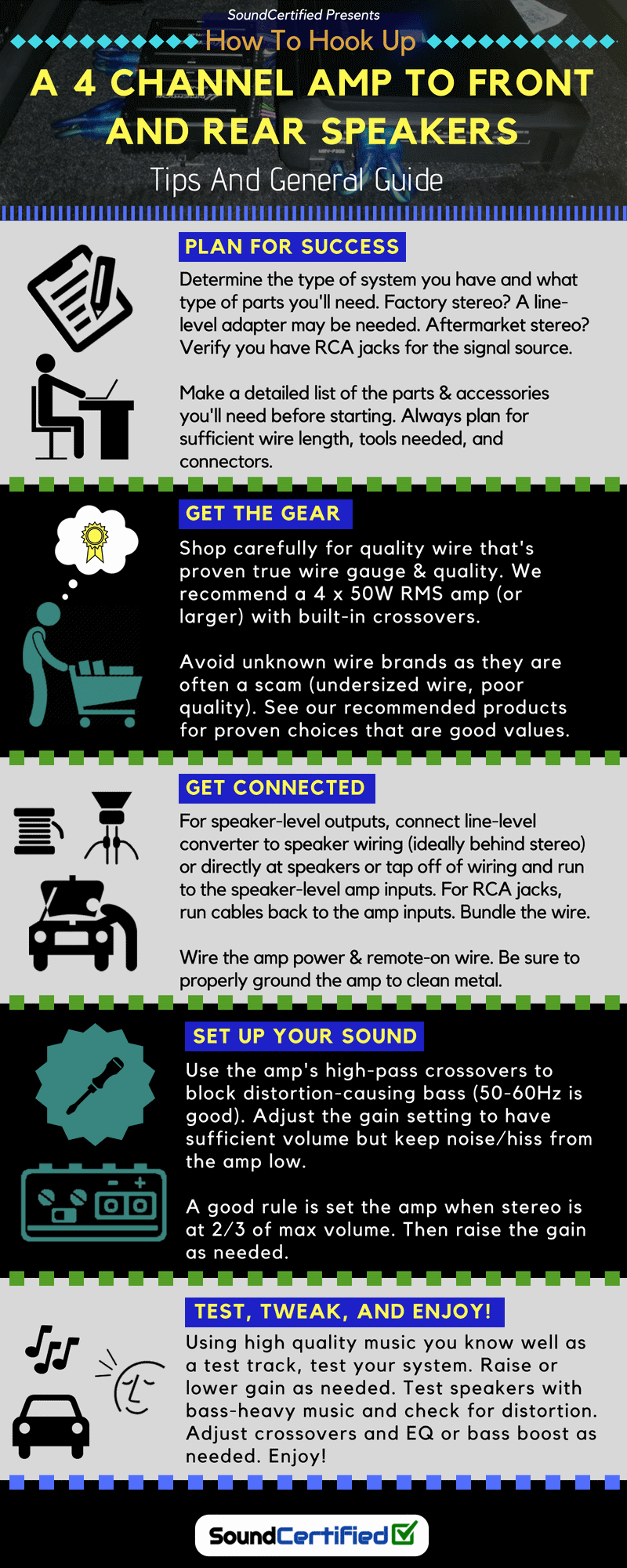
Basics first
If you’re reading this there’s a good chance you’re not familiar with installing an amp, connecting wiring, and other details related to hooking up a 4 channel amp in a vehicle.
Not everyone has installed car stereo equipment before so I’m going to be as thorough as possible and avoid making any assumptions about how much you know.
What is a 4 channel amp?
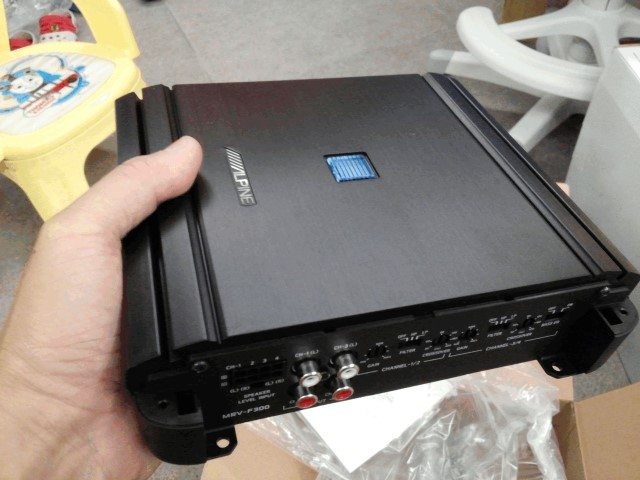
Today’s 4 channel amps offer newer technology, better sound, and more compact size than in the old days. An excellent example is the Alpine MRV-F300 50W x 4 model. It uses class D amplifier technology to run extremely cool and yet it’s small enough to fit under a car or truck seat. Very nice!
What a 4 channel car amplifier is may seem obvious at first but there’s a bit more to know Additionally, there are some interesting (and good) ways they differ from 2-channel amps.
In fact, there are actually a few benefits you’ll get using one 4 channel amp instead of 2 stereo ones to power your front and rear speakers.
4 channel amplifiers add more channels into a more compact and efficient design than separate amplifiers would have.
Additionally, they offer more flexibility, as most can be configured for “bridged” operation which can give more power when you don’t need all 4 channels.
What is “bridging” an amp?
Bridged mode capability is a special design feature in which a “push-pull” set up is created: one channel (normally used for the left speaker) produces a signal that’s the opposite of the second channel (normally used for the right speaker).
This causes the speaker to receive a voltage audio waveform that is the difference between the two channels – resulting in more available power to speakers.
Essentially, bridged mode is a flexible way to get more power if you’re not driving 4 speakers. It means 2 channels are sharing the workload of one speaker between them and therefore and drive it with more power. That’s helpful if you’d like to hook up 4 speakers and a sub to one amp.
2 channel vs 4 channel amp diagram
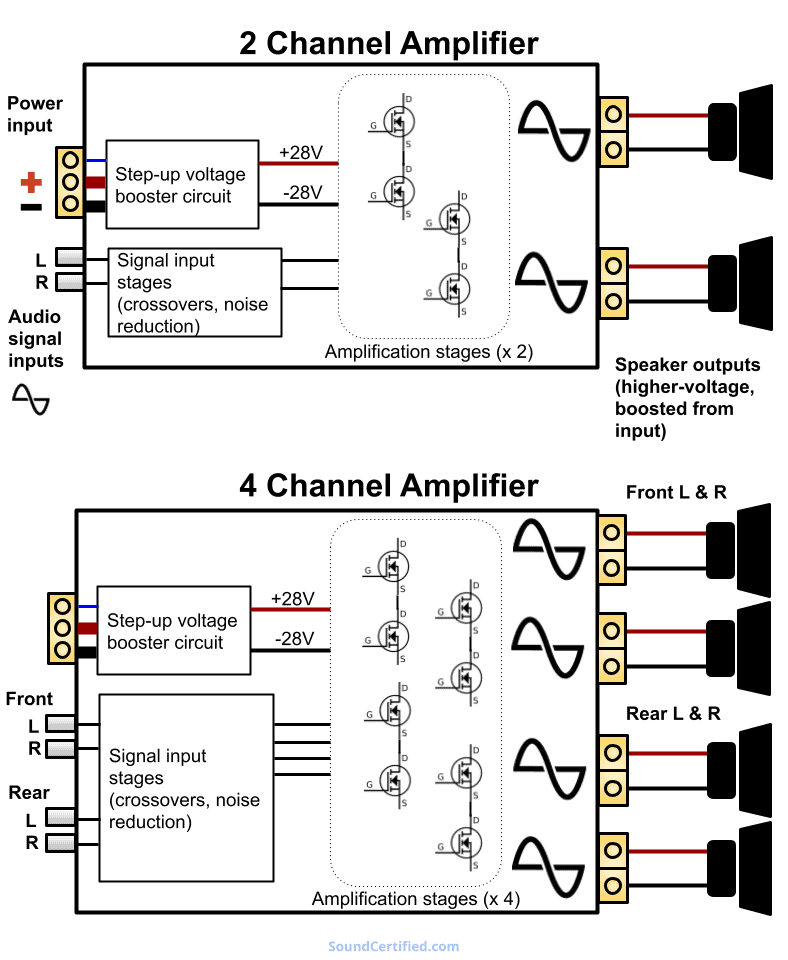
A 4 channel car amp is basically an expanded version of a 2-channel amp. However, because they’re built together and not 2 separate 2-channel amps, they’re more compact. This saves installation space and makes it easier too. Additionally, most can be bridged to use 2 channels (or 3, depending on your needs) so you’re not restricted to using them with only 4 speakers.
The benefits of using an amp to drive speakers
Whether you have a factory stereo or a great aftermarket (non-factory) one, adding an amplifier is one of the best decisions you can make.
In-dash stereos are very limited in how much power they can produce. They can’t drive speakers with the same clarity and low distortion as a good amplifier can.
The maximum volume you’ll be able to get from your speakers will be pretty low, too.
When a signal is boosted and sent out to your car’s speakers the voltage is much higher and the speaker can receive much more power.
That’s why tiny amplifiers are rarely worth bothering with – if there’s no special power supply inside, it’s simply not capable of producing much power.
Getting great sound
Powering speakers from an amp makes a big difference, and I’ve enjoyed excellent sound for years this way.
When an amplifier drives your vehicle’s speakers it’s often not even pushed to its limits. The sound produced at the speaker has lower distortion, doesn’t “bottom out” when heavy bass is played, and you can get a lot more volume, too!
Additionally, using an amplifier with built-in high-pass crossovers means you can block out lower-end bass that causes your speakers to distort and attempt to play music tones they’re not suited for.
The result is cleaner sound, less distortion, and great volume – you can crank your music even higher!
Just imagine driving down the road with the windows open and finally being able to blast the music you love. I’m confident you’ll love it as much as I do.
Things to know before you start

It only takes a few minutes to make a list of the parts, wire, tools, and other bits and pieces you’ll need. Planning ahead can mean the difference between getting your system going without major problems or having a frustrating time – or complete failure! I always get organized and get my items together before I start a job.
Planning is very important. You don’t want to run out of wire or discover you don’t have the rights parts, for example. That will mean you can’t finish your project.
It’s even worse when you have to drive around town searching for items, or you can’t do anything after stores close. Believe me, I’ve been there, and it’s terrible!
Notes about wire, tools, and a few other things
When it comes to installations, always plan to have more, rather than not enough, wire. This goes for speaker wire as well as RCA cables.
The amplifier kits I recommend have the right length for your amp installation, but speaker wire & RCA cables are another matter in this case.
What length and size of speaker wire do I need?
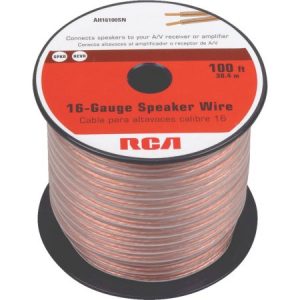
There’s no need to spend an excessive amount of money on speaker wire. 18 gauge is enough for many installations, but 16 gauge is a great choice too if the price is right. A great example is this AmazonBasics 100 foot roll. I recommend a 100 foot roll for many installations with a 4 channel amp (see why below).
Here’s an estimate of the worst-case scenario for the length of speaker wire required. I’ll use the example of installing an amp using speaker-level inputs, with the following typical installation:
- The amp is located in the trunk
- Speaker level signal connections near the radio (center console)
Let’s use roughly a 15′ length of distance from the radio to the amp. That’s a good estimate in my experience.
So we have:
- Wire from the radio to amp (signal wire): 4 channels x 15′ = 60 feet
- Wire from the amp to speaker wiring near radio: 4 channels x 15′ = 60 feet
Total estimated wire required: 120 feet.
That means you need 2 100 ft rolls of wire. Or at the least, 1 100 ft roll and 1 50 ft roll. If you’re planning to use a line-level adapter, expect to pick up a 100′ roll.
If your installation is using RCA jacks, expect a 100 ft roll also (4 channels x 15′ length estimate for the speaker wire from the amp).
What about RCA cables?
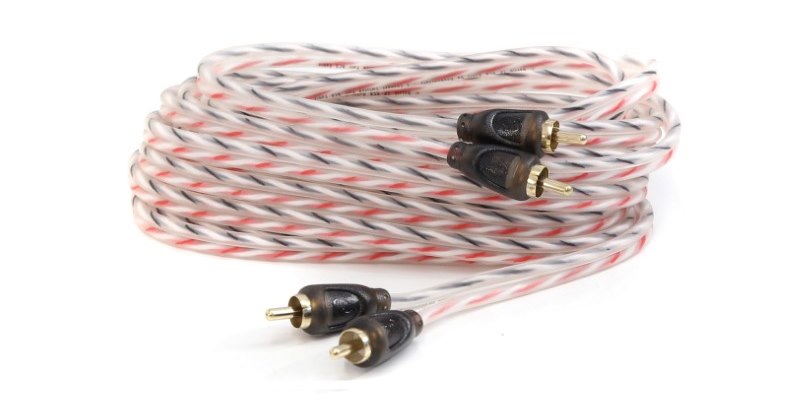 If you’re installing a 4 channel amplifier and using RCA cable connections, you’ll need to buy a 2nd pair along with your amp wiring kit, as most only include a 2-channel cable.
If you’re installing a 4 channel amplifier and using RCA cable connections, you’ll need to buy a 2nd pair along with your amp wiring kit, as most only include a 2-channel cable.
For most installations, I recommend 18′ length cables. That’s usually long enough for most vehicles and you should usually have enough length to hide the cables inside the interior and under the rear seat, etc.
There’s no reason to spend an excessive amount of money. Just pick up some good quality, well-made cables. Even No products found. will be fine in most cases.
Tools you’ll need
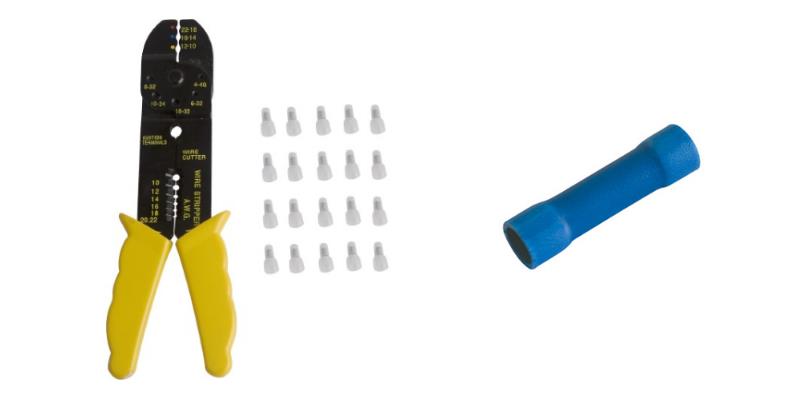 Crimp tools are great for installing your amp and speaker wiring with professional results. If you’re doing your own installation, you can get by with an inexpensive tool like this Pros'Kit crimp tool. Crimp connectors are sold separately in many automotive parts stores or general stores and are very affordable.
Crimp tools are great for installing your amp and speaker wiring with professional results. If you’re doing your own installation, you can get by with an inexpensive tool like this Pros'Kit crimp tool. Crimp connectors are sold separately in many automotive parts stores or general stores and are very affordable.
I recommend a few tools. If you shop carefully, you can avoid getting ripped off on tool prices. When connecting speaker wiring to factory wiring, it’s easier to use crimp connectors than solder.
Never simply twist the wire together and wrap it in electrical tape. Always use a reliable connection.
During warm weather, electrical tape adhesive can fail and the tape can come off of the wire. This exposes it to possible short circuits and potential damage to your radio or amp.
If you have access to a cordless drill, that’s fantastic! They’re great for drilling holes in the vehicle’s metal for mounting your amplifier or connecting the ground wire to bare metal.
I also recommend the following:
- Wire cutters (some crimp tools have this built-in)
- Roll of quality electrical tape
- Wire ties (“zip ties”), 6″ length, bag of 100
- A digital test meter for voltage measurement

A test meter is often incredibly helpful when installing an amplifier. However, you don’t need to spend much money! No products found. will work great.
I recommend getting an affordable but good digital test meter to find a switched +12V wire for getting a remote-on signal to the amp.
They’re also extremely helpful when troubleshooting power problems when something isn’t working.
Get your installation shopping list together

Here’s a general but pretty accurate list of what you’ll need for connecting a 4 channel amp to front and rear speakers.
Installation types 1 or 2: Factory radio or no RCA connections
- 4 channel amplifier with speaker level inputs or amp and line-level adapter
- 120 feet or more speaker wire, 18 gauge or larger
- Amp wiring kit
- Crimp tool and butt (wire crimp) connectors (25 or more at least)
- Cutting pliers
- Electrical tape
- Wire ties, 6″, bag of 100
- Test meter
Installation type 3: RCA connections
- 4 channel amplifier with speaker level inputs or amp and line-level adapter
- 100 feet roll speaker wire, 18 gauge or larger
- Amp wiring kit
- Additional RCA cables, 18′ minimum
- Crimp tool and butt (wire crimp) connectors (25 or more at least)
- Cutting pliers
- Electrical tape
- Wire ties, 6″, bag of 100
- Test meter
Be sure to plan well and estimate the amount of speaker wire you’ll need. For the amp installation itself, I strongly recommend using a pre-made amp wiring kit like you’ll find here in my amp kit buyer’s guide.
You’ll also need to get a 2nd pair of RCA cables. I recommend 18 ft length or more. Don’t spend too much money, but do get decent quality ones.
How to get a signal to your amp
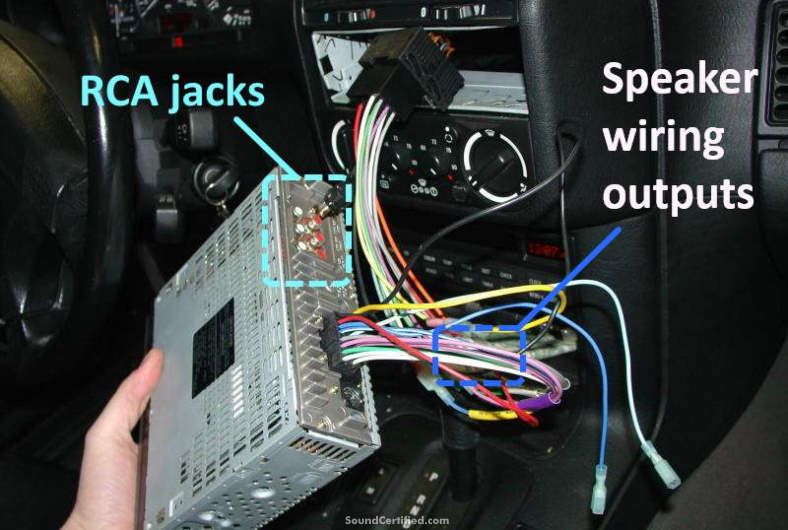
Image of an aftermarket (non-factory) stereo showing the RCA jacks and speaker output wiring. Either one can be used for getting a signal to an amp, but RCA jacks offer a better option. They’re normally lower distortion and allow using plug-in RCA cables. If those aren’t available, either an amp with speaker-level inputs or a line level (speaker level) adapter can be used.
In order to install a 4 channel amp and drive all 4 speakers, in many cases, the biggest obstacle is getting a signal to the amp. Once that’s done, the rest is usually a standard amp installation.
There are 3 basic ways to get a signal to your 4 channel amplifier:
- Connect speaker outputs to your amp’s speaker level inputs
- Connect a line-level adapter to the radio then use RCA cables to the amp
- Connect your radio to the amp using RCA cables directly
In that case, my advice is to speak with a good installation shop first and do your research.
If you feel that factory amplified systems should be here as well, send me a message or comment and let me know
In a few cases, adapters are available to connect an amp to a factory amplified system’s audio wiring, but it’s often difficult or there are obstacles you won’t find until you get started.
One of the reasons why is that factory amplified systems often have non-standard wiring connections for the audio path and are prone to bad noise problems if you connect an amplifier without the proper adapter or wiring.
Which type of connection do I need?
If you have a radio with RCA jacks, skip on down to the next section.
However, if you have a stereo with no RCA jacks (which is always the case for factory-installed stereos) you’ll have to buy one of the following:
- A “line level” converter
- An amplifier with speaker-level (“high level”) inputs
1. Line level converters
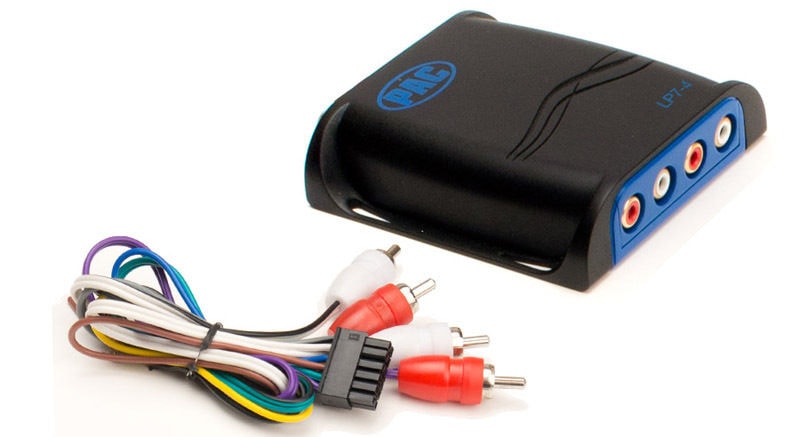
Line-level converters like this PAC LP7-4 4-channel model are designed to take speaker-outputs from a stereo with no RCA jacks and adapt them to RCA jacks. Using this, you can run RCA cables to your amplifier.
Line level converters are designed to allow connecting to an amplifier’s RCA inputs by converting speaker outputs from a stereo to a low-level signal an amp can use.
It’s very important to buy a quality, well-designed line-level adapter to avoid noise, poor sound quality, and other problems. Don’t get the cheapest – instead, get a name brand model you can rely on (like the one above).
2. Speaker level inputs
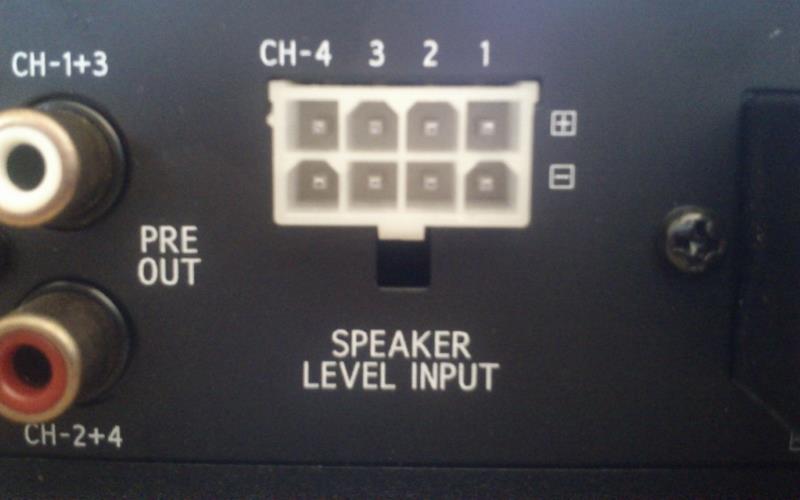
Amplifiers with high-level (speaker-level) inputs like this one allow connecting to speaker wiring for a signal source. This avoids having to buy a separate adapter.
Speaker level inputs are common on many 4 channel amplifiers. These amps contain electronics that scale down speaker wiring signals to a lower signal safe for the amplifier’s input circuitry.
They’re simple to connect: normally it’s just a matter of connecting both positive (+) and negative (-) wiring for each speaker channel on a small wiring harness included. This then plugs into the speaker level input connector.

A typical speaker-level input harness for a 4 channel amp. The wires are color-coded to make installation easier. White = left front, gray = right front, green = left rear, and purple = right rear.
While it can save money (you won’t need a line-level adapter in this case) I often recommend that people consider buying a line-level converter anyway.
This allows an easier upgrade for your stereo later, which is very common for people to do. Using the line-level converter now will allow you to run RCA cables to your 4 channel amp to be used later if you buy a better stereo (which will include RCA jacks, almost always).
3. RCA jack (line-level) connections
RCA jacks offer a clean, lower-noise connection than speaker-level adapters do, but honestly, it’s not noticeable to the average person. RCA cables (line-level connections) are the preferred way to connect a signal to your amp if you have that option.
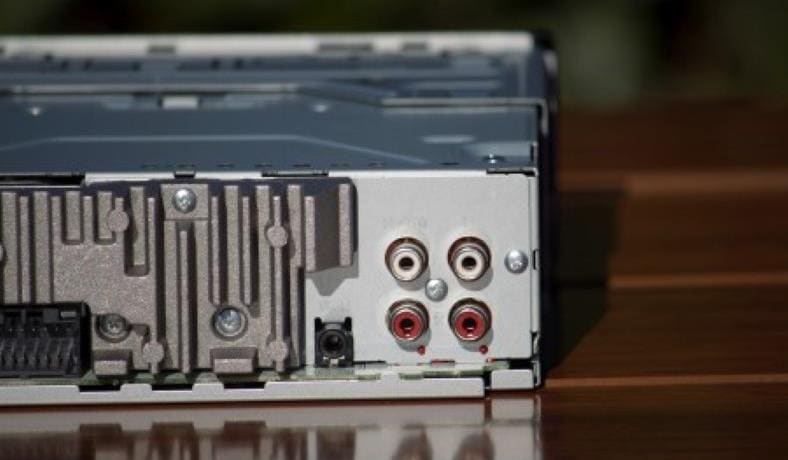
RCA jacks on the rear of a Pioneer head unit. This is the ideal way to connect your amplifier’s signal inputs, if available. For a 4 channel amplifier, you’ll need 2 stereo RCA cables to do so. White represents the left channel white red represents the right. These are standard colors for audio outputs for both car and home stereo.
If your stereo has RCA jacks, then congratulations. Things just got a bit easier – and potentially better sounding, too!
You’ll need 2 stereo RCA male-to-male cables (4 audio channels total) to run from the radio to your 4 channel amp. That’s 4 signal channels: left & right front and left & right rear.
4 channel amp signal connection diagram
Here’s a helpful diagram showing the most common connections you’ll need to make one of the 3 most common cases I mentioned earlier:
- Connecting to your amp’s speaker level inputs
- Using a line-level converter
- Connecting your amp to the radio’s RCA jacks

You can also click here to view the .pdf document for print or download.
Connecting and running signal wiring
Speaker-level connections
As mentioned above and as shown in the diagrams, if you’re using speaker-level outputs to get a signal from the radio, you’ll need to connect wire. Ideally, you’ll do so near close to the radio, then run the wire together as a bundle.
You can bundle speaker wire together with wire ties to keep it neat and make the installation easier.
Estimate the length of speaker wire you need to reach the amp (or line level converter) for each audio channel. To do so, run a length of wire from the radio to where the amp will be installed, then allow a little extra and enough length to run around curves and interior parts.
Cut 7 more lengths of wire, for a total of 8:
- 4 channels (4 pairs of wire) going to the amp’s speaker level inputs
- 4 channels from the amp to the radio’s factory speaker wiring
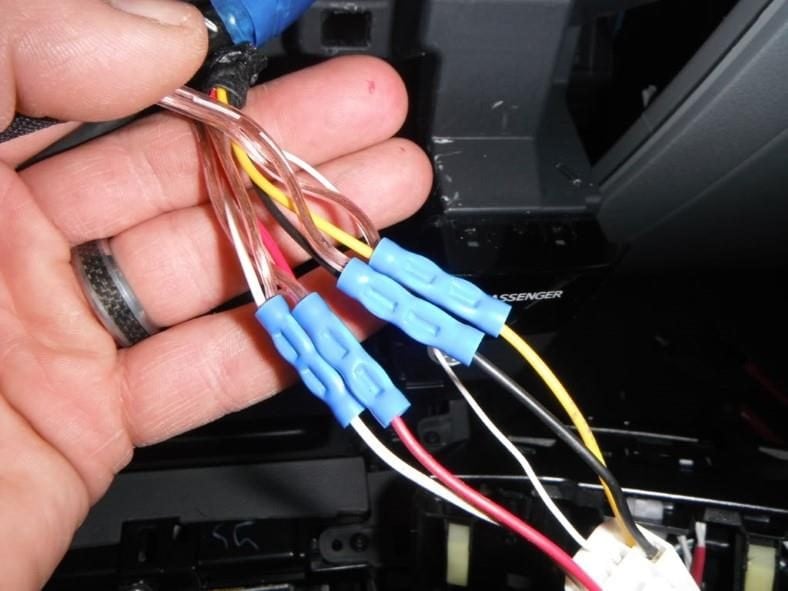
I recommend connecting to speaker-level outputs using crimp connectors and a crimp tool for a reliable, solid connection. Blue connectors are normally the right size for 18-16 gauge wire.
Factory stereo color codes
If you have a factory stereo, you’ll need to find the wiring colors for the speaker wiring.
A great resource for that is The12Volt.com, where you’ll find wiring diagrams for your vehicle and color codes listed.
Making connections
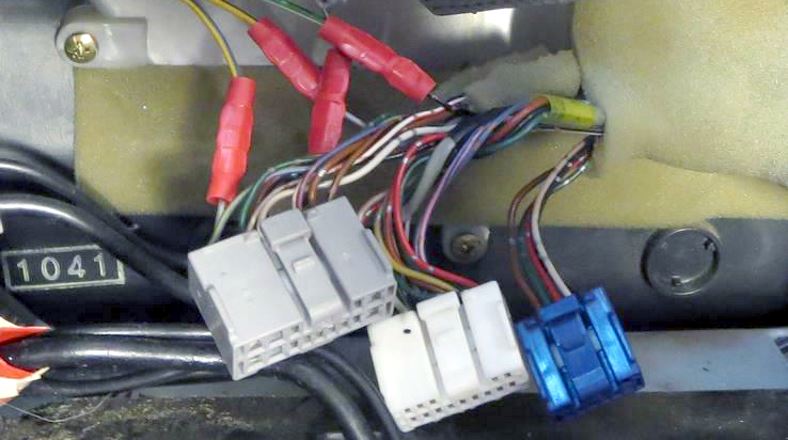
After removing the radio you’ll find connectors like this for the factory stereo wiring harness. You’ll need to separate the speaker wires, cut them, and attach wiring to run to the amp.
Remove the radio and disconnect the factory wiring plugs or aftermarket radio’s wiring harness.
Cut the speaker wires, leaving enough length to move the wire and to have enough length to connect to the wire freely.
Strip a small part on both the stereo’s speaker wire and your amp speaker wiring. If using a line-level adapter, connect to the stereo’s speaker output side. Then connect the 4 pairs of wire to the speaker wiring in the harness.
Insert the stripped wire (about 1/4″ of bare wire) into the connectors and crimp them carefully using a crimp tool if you have one. Alternately, you can twist together wire, solder it, and carefully wrap it with electrical tape or use heat shrink tubing for insulation.
If using speaker level inputs on your amp, also connect 4 pairs of wire to the output of the stereo.
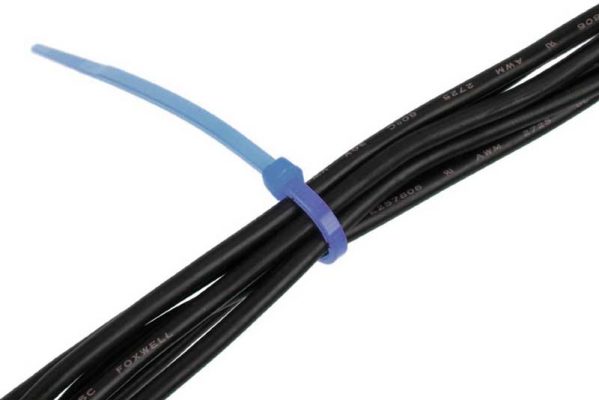
To make a neater, more professional installation, bundle the speaker wiring similar to this using wire (“zip”) ties. I recommend using 6″ ties which often are sold in packs of 100.
Once all wiring is connected, bundle it up using wire ties or, optionally, a little bit of electrical tape wrapped around. In both cases spacing out wire ties or tape about every 1″ or 1.5″ along the length of the wire works well.
Connecting RCA cables
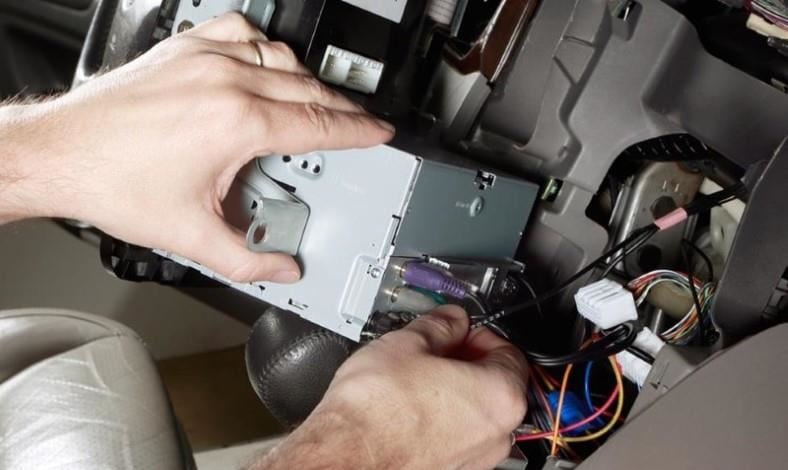
Connecting RCA cables to an aftermarket (non-original) stereo for running to an amplifier.
If you’re using a line-level converter or have a stereo with RCA jacks, connect all 4 cables plugs to the front and rear outputs.
RCA cables are sometimes marked with left and right symbols (“L” and “R”). In some cases, white, clear, or some lighter color can be used to represent the left channel.
Connect the cables consistently so you’ll be able to recognize which one is which. If the front and rear RCA cables are the same, you might want to mark front and rear using some masking tape and a marker or pen.
Connect the remote-on amp wire
Don’t forget the remote wire! Amp wiring kits include a small wire that’s used to connect the amp so that it switches on and off with the accessory position of the ignition switch.
Locate a +12V wire that has power when the ignition is switched to “ACC” or similar but turns off with the key. You may also have good luck finding an existing wire color from vehicle wiring diagrams I mentioned earlier or from a Google search.
I recommend checking the wiring even if you have already located it online, just to be sure.
Before re-installing the radio connect this wire and run it alongside the speaker wiring.
How to connect a 2 ch. car stereo to a 4 channel amp
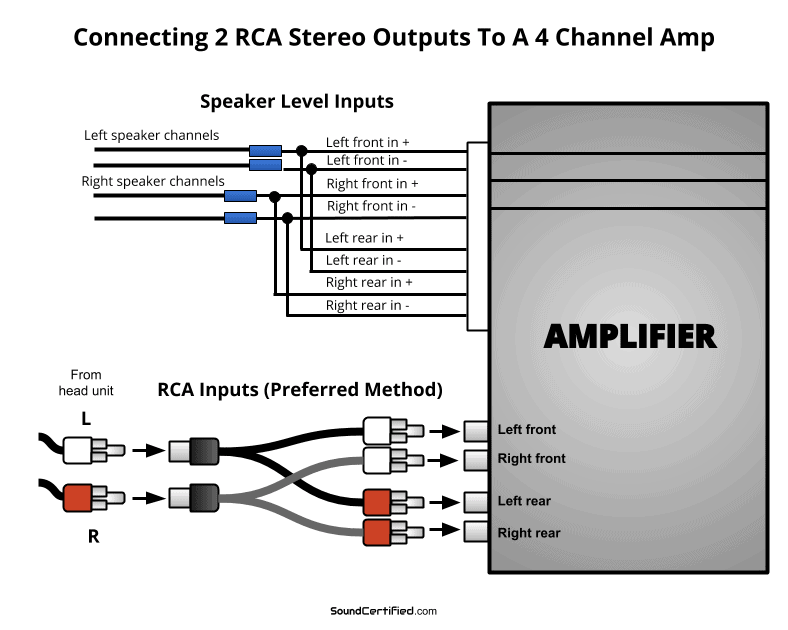
You can connect a head unit car stereo with only 2 channels (left and right) to a 4 channel amp easily. Ordinarily, all you need is 2 RCA Y adapter cables. The head unit’s left channel RCA jack should be connected to the left front and left rear amp inputs. Likewise for the right channel. If using speaker level inputs on the amp, use the connections shown above. NOTE: Use only ONE of the two connections above! Never connect both types at the same time! Speaker-level outputs will damage RCA connections.
If your head unit (car stereo) only has 2 RCA jacks or two pairs of speaker outputs, that’s not a problem.
As shown in the above diagram, you can connect 2 channels to a 4 channel amp using either the speaker level inputs wired in parallel or by using simple RCA adapter cables.
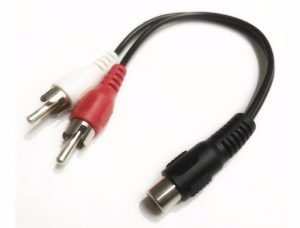
All you need is a decent pair (a total of 2) female to male RCA “Y” adapters No products found.
The sound quality will be exactly the same. Today’s amps are designed in such a way that there’s no harm in using a Y adapter to connect the amp. The amplifier will receive exactly the same signal, with the same quality, in the front channels as well as the rear.
The only drawback is there won’t be a front to rear fader control like with head units with 4 channels of outputs.
After connecting the stereo to the amp, you’ll need to adjust the rear gain to set the volume level for the rear speakers as needed for the proper volume depending on the stereo’s signal strength.
Installing the amp
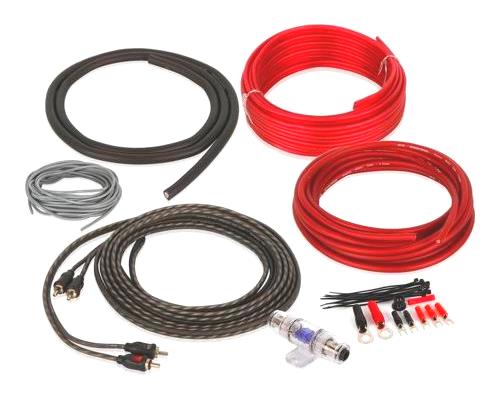 An amp wiring kit like this one will make installing your 4 channel amp much easier. A good-quality one like this Belva 8-gauge complete kit includes not just wiring but much more. You’ll also need to pick up a 2nd pair of RCA cables (if using them) and enough speaker wire.
An amp wiring kit like this one will make installing your 4 channel amp much easier. A good-quality one like this Belva 8-gauge complete kit includes not just wiring but much more. You’ll also need to pick up a 2nd pair of RCA cables (if using them) and enough speaker wire.
Your amplifier needs a good solid metal connection to ground and you’ll need to run the positive battery wire to the engine compartment. Your amp wiring kit will also include a fuse holder that should be installed near the battery as well (most kits include instructions, by the way).
You’ll also need to connect the amp’s speaker outputs to the wire you ran from the radio. Here’s a basic diagram as well to help:
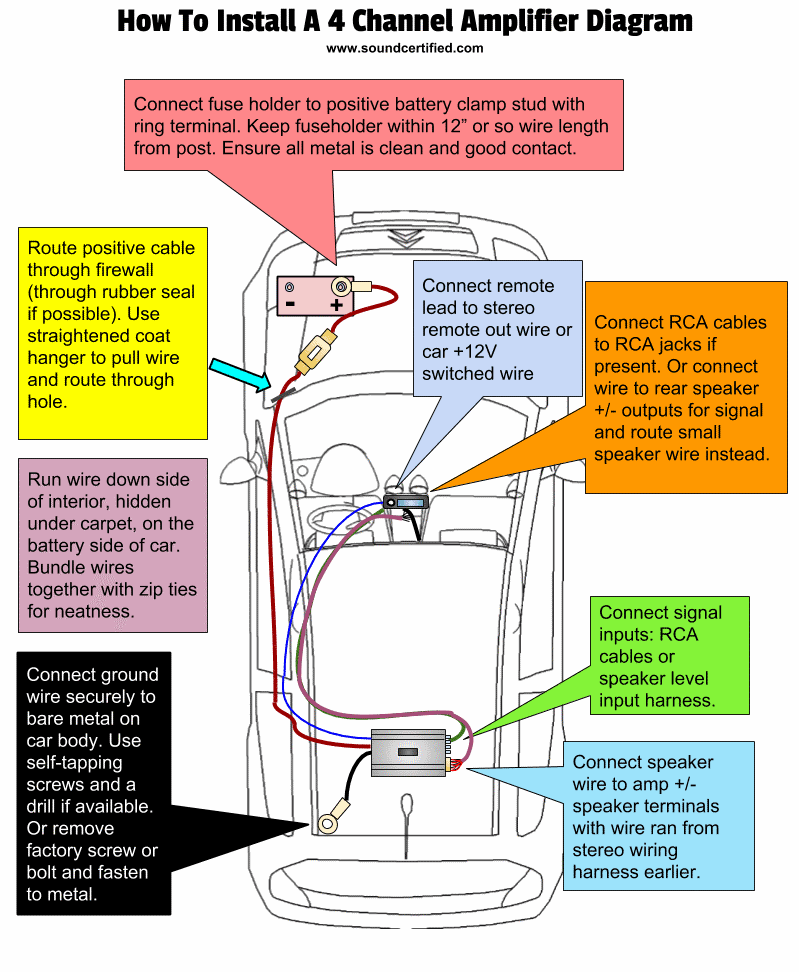
Setting up your amp
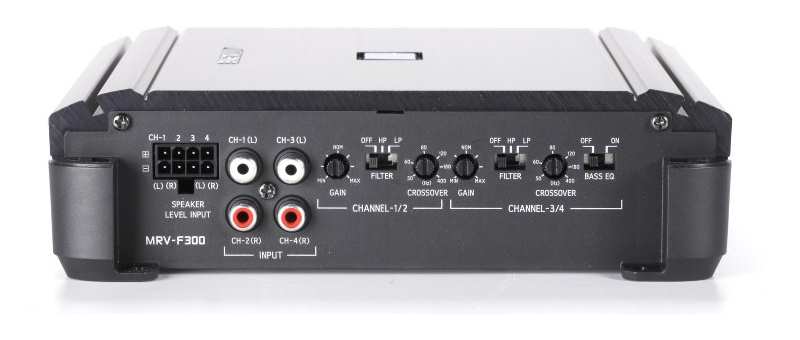 Once installed, you should set up your amp’s gain levels and crossovers for the best sound. In this image, you can see the adjustable crossovers for both front and rear channels. Turn on the high-pass crossovers and adjust to a setting close to 50-60Hz, to allow good bass for music but block low-end bass that distorts.
Once installed, you should set up your amp’s gain levels and crossovers for the best sound. In this image, you can see the adjustable crossovers for both front and rear channels. Turn on the high-pass crossovers and adjust to a setting close to 50-60Hz, to allow good bass for music but block low-end bass that distorts.
Once installed, you’ll need to set up your amp’s gain levels and crossovers, if available. Most sold today have that. (See my recommendations at the end for some great models)
Gain control is the amount of signal amplification the amplifier performs. Ideally, with a good input signal, it can be kept low to reduce any hiss or noise that can appear when it’s turned up high.
Here’s a great rule of thumb for how to adjust the gain for this type of system:
- Turn down gain controls on the amp
- Turn the stereo’s volume to 2/3 of maximum
- Slowly raise the gain controls until the volume is enough
When finished you should have enough volume available from the stereo but noise should be minimal. You’ll still need to tweak it a bit if the volume is too high or too low.
Setting the crossover
As I mentioned at the beginning of this guide, using high-pass crossovers will allow more volume with less distortion and will help protect the speakers from heavy bass.
For both front and rear channels turn on the high-pass feature and, if an adjustable dial is available, set it near 50 to 60Hz. Some models don’t offer an adjustable frequency for the cutoff but are likely preset to a good level.
Test and tweak
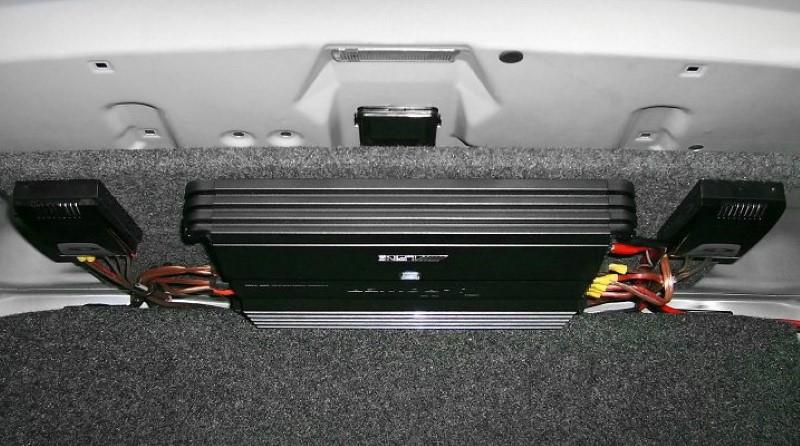
Once installed, test and tweak your amplifier as needed. A great way to mount your 4 channel amp is by using a board mounted to the car, covered with speaker box carpet or other material.
Play some music you’re very familiar with and adjust things like bass, treble, and the fader as needed. Using music you’re very familiar with (of high quality) means you’ll be able to notice any problems with the sound fairly easily.
If you don’t already have one, you might consider later upgrading to a head unit with built-in equalizer (EQ) functions to help tailor the sound.


Hello Marty
I’m discovering your site only today and I already learned so much, it really is so informative, congratulations for the superb job !
I am looking at upgrading / improving my current installation. Just starting so complete newbie to the domain of car audio.
The car is a 1985 Porsche 928 which still has its original 4 pairs of factory speakers : 1 tweeter and 1 mid range in the door, and 1 bass and 1 midrange in the rear. All speakers have 4 ohms impedance. I don’t know the power but I don’t think it’s very high. The speakers all look in relatively good shape and I’m not sure there is much point in changing them, as I understand the technology for speakers has not made giant steps in the past 40 years and the benefit from changing would probably not be that spectacular. Anyway, perhaps I will end up changing, but that’s not the first thing I’m looking at.
My audio unit is about 15+ years old, it’s a Panasonic cq3550n. It’s quite good material from the reviews I’ve seen. Its output is 4x50W RMS at 4 ohms. Again, I may buy a newer unit to be able to play Spotify from my iPhone directly via Bluetooth, but I’m not expecting a newer unit would improve sound quality in any significant way compared to what I have today.
So … what I’m looking at first is to insert an amplifier between the unit and the speakers. I found one from Focal, model 4.320. It’s a D-class and it’s very compact size, which is what I’m looking for because I don’t have much space. However I read that the specs are also 4x50W RMS under 4 ohms. So I’m wondering if I would experience any noteworthy gain in introducing this in my installation, since it’s got the same output specs as my head unit? Wouldn’t it be beneficial only if the power was higher, or impedance was lower?
Thanks in advance for your help and congrats again for the high quality work.
Yves
Hello there, Yves. The Panasonic head unit, and others like it, don’t have 50W RMS per channel, but rather closer to ~10W per channel. The “50 watts” spec is a bit misleading as that is “peak” power, not power it can provide continuously.
The amplifier can definitely provide better sound, power, and volume if you use it to drive the speakers. At least, since you’re getting a good brand amplifier the audio quality will be good.
It appears that the Panasonic has an AUX input on the rear so you can use it for sound from your phone until you’re able to get a Bluetooth unit installed. Thanks for your kind words about my website – it is appreciated!
Best regards!
Hi Marty
Indeed you’re absolutely right. I just took a second look at the panasonic manual and it does say that 4×50 is the MAX output power.
The line immediately below in the manual says that the output power (with no adjective) is 4x22W, so I guess that this is the “real” number I need to consider?
And then, immediately following between brackets, there is comment saying “(DIN 45 324 at 4Ohms)”. How does that comment matter?
Many thanks again !